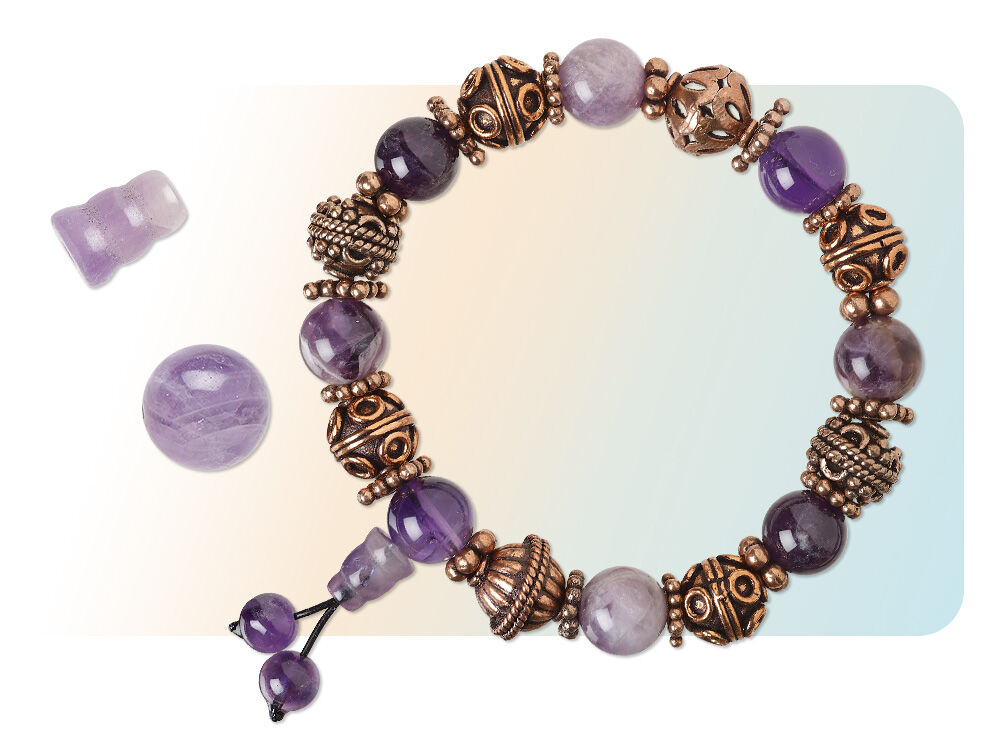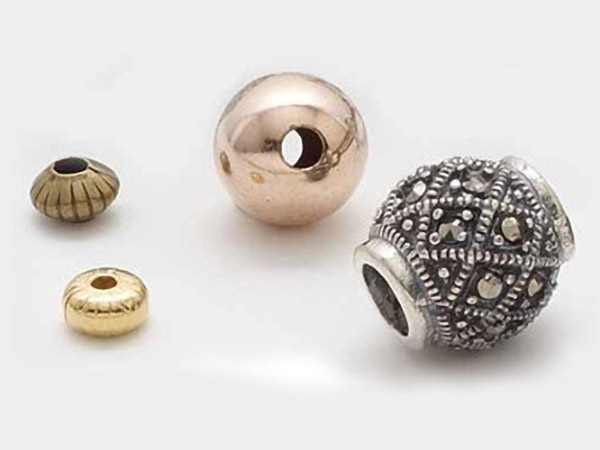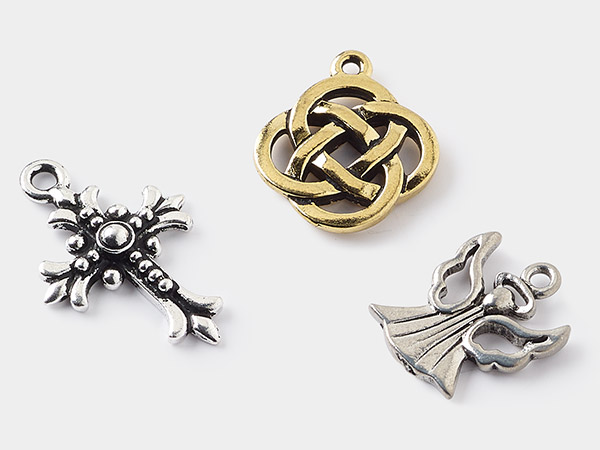Mala Beads: How to Make Your Own Mala
What is a Mala?
A mala is a single strand of beads used to keep track of how many times you've repeated a mantra, prayer or other positive affirmation. Malas are also used to count breaths or series of yoga poses. Mala beads are also called mantra beads, meditation beads, Hindu rosaries or Buddhist prayer beads. A yoga mala is tied to the ancient tradition of doing 108 sun salutations each day, which is usually performed during periods of seasonal change.

So much more than simple trackers, malas are spiritual tools found in yogic or Buddhist meditation. There are multiple types of malas: necklace mala, half mala and wrist mala. Necklace malas are the most common and can have the guru bead (also referred to as teacher, meru or mountain bead) down by your heart or behind the neck. But if you have additional embellishments, such as symbolic focals or tassels, they would be hidden if worn the second way. Half malas are often worn as necklaces. Wrist malas are worn as bracelets. Necklace and half malas can also be worn on the wrist by wrapping them.
You don't have to be Buddhist, Hindu or a yogi to use malas. The concept of chanting, saying repeated words or tracking spiritual repetitions has a presence in many cultures across the globe throughout the centuries. For example, prayer beads, rosary beads and worry beads have been considered types of malas. The Catholic rosary is said to have been created during the 9th century in Ireland and is used to keep track of particular prayers.
What is the Purpose of a Mala?
There are multiple benefits to mala beads, whether you want to make and sell them to others or make and wear them yourself. The purpose of a mala is to:
- Function as an anchor and increase focus, especially during japa meditation or yoga
- Count mantras (japa meditation) or prayers
- Promote inherent healing and metaphysical energies through physical contact with specific gemstones
- Help determine goals and focus your intentions—especially if you have different malas with different significances such as a mala dedicated to stress relief and another for when you need a boost in confidence
- Uplift and encourage with a beautiful piece of jewelry that is a reminder for the wearer of their intentions and goals, even when not performing yoga or meditating
How to Use a Mala
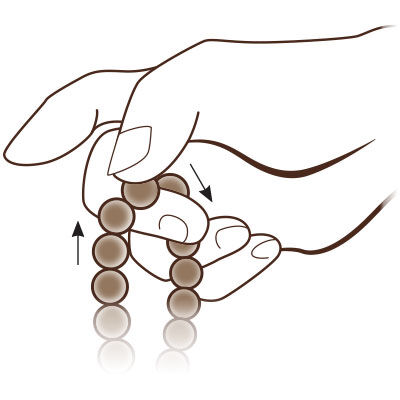
Traditionally, a mala is used while in an easy sitting pose such as the hero or half lotus. A quiet room with dim or soft lighting typically works best for maximum concentration. Hold the mala in your right hand draped over your middle finger and use your thumb to touch and scoot along the japa mala beads. Don't let your index finger touch the beads since it can represent ego, which is said to be the greatest obstacle in attaining enlightenment. Start on a bead next to the guru bead. The guru bead is not meant to be touched or counted during meditation. Close your eyes or allow your vision to relax and not focus on any specific object in the room. Say your mantra out loud or mentally and then pull the next bead towards you.
If you're using a half or wrist mala, you'll need to repeat through the beads, but don't pass over the guru bead. Instead, flip the mala over and begin again or go back the direction you came from. The more often you meditate with a mala, the more your mala beads are able to absorb the vibrations. It is believed that this process enables the beads to amplify the energy they reflect back during use.
How Many Beads in a Mala?
There are 108 beads in a traditional mala. Half malas have 54 beads and wrist malas have any number of beads, as long as they can be multiplied to equal 108. Why do malas have 108 beads? Because 108 has been a powerful number in India for centuries:
- Vedic mathematicians estimated the sun's diameter is 108 times larger than the Earth's diameter
- Vedic mathematicians also estimated the distance between the sun and Earth to be 108 times the sun's diameter
- There are 108 sacred texts of the Upanishads in the yogic tradition
- There are 108 pithas (sacred holy sites) in India
- There are 108 marma points, or junctures on the body where two or more tissues meet. Marma points represent more than physical connection and are considered points of vital life force
- In Bhakti yoga tradition, there are 108 gopis dancing with Krishna in Vrindavan
- There are 108 names for the goddess Krsna (Krishna)
- In tantric yoga, there are 108 energy lines in the body that converge at the heart chakra
- There are said to be 108 earthly desires in mortals
- 9 and 12 are other sacred numbers: 9x12 = 108
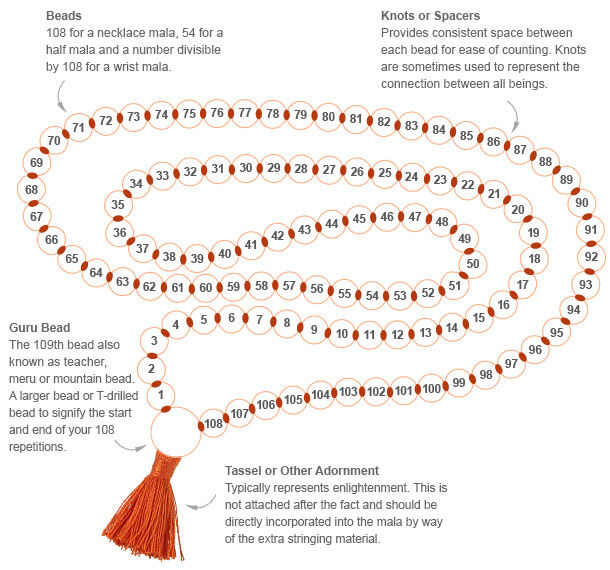
What Beads Are Used in Malas?
The most common beads used in malas are wood, seeds or semiprecious gemstones. For example, in India, it's common to find malas made with sandalwood and rudraksha seeds. In Nepal, you could find malas that incorporate bodhi seeds and lotus seeds. The materials you choose play a large part in the energy, spirit and healing beliefs of your mala. The beads are most commonly 6mm, 8mm or 10mm rounds. Of course, you can choose whatever size works best for you. Bigger beads can help with counting, especially if you're new to japa meditation, but it does result in a much larger mala. Mala beads can all be the same gemstone, or you can choose several to focus on particular chakras, desired healing results or special meaning.
Other Materials in Malas
Small metal spacers between each bead or other decorative beads can be included for aesthetic purposes, but are not counted during meditation. In some countries, knots are placed between each bead on a mala to protect the beads from clacking against each other. Cotton, nylon, hemp or silk are the most common stringing materials used for malas, which are easy to knot. Lastly, malas are often finished with a tassel made from the same stringing material as the mala. Other adornments are up to you!
How to Pick Bead for Use in a Mala
Which mala beads should you use? The meaning of mala beads is unique to each creator of mala jewelry and those who wear malas. First, you need to determine what goals are most important to you, areas of your life you want to focus on or improve, and difficulties you're facing. Be specific in your determinations to make it easier to find the perfect gemstone(s) for a mala full of intent.
Some ideas on how to pick mala beads include:
1. Metaphysical Mala
The belief that gemstones carry energy is the basis of choosing beads based on metaphysical qualities. According to practitioners of crystal healing, gemstones carry power or energy vibrations to help direct spiritual and sometimes physical changes such as healing. Below are listed some common metaphysical traits and their associated gemstones*, though this is far from a complete list of what you could choose from.

2. Chakra Mala
Chakras are centers of energy in the human body associated with various traits. There are different schools of beliefs regarding the number of chakras, but there is a commonly accepted 7-chakra system that begins at the top of your head and ends at your feet.
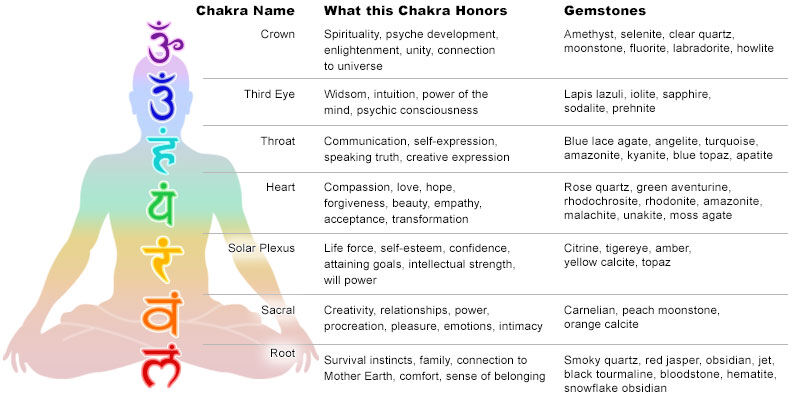
For more detailed information, read the ''Chakras and Their Gemstones'' article.
3. Zodiac Mala
Choosing mala beads based on your zodiac sign is based on your birthdate, but not necessarily your birthstone—which of course you're still welcome to use. Zodiac gemstones, also called astral stones, are a representation of your astrological sign and therefore respond particularly well to certain stones. There are also planetary stones stemming from an ancient belief that gems have associations with planets and therefore the signs have ruling planets. Talismanic stones are said to give additional protection and powers. These stones must be cut or engraved with the zodiac sign.
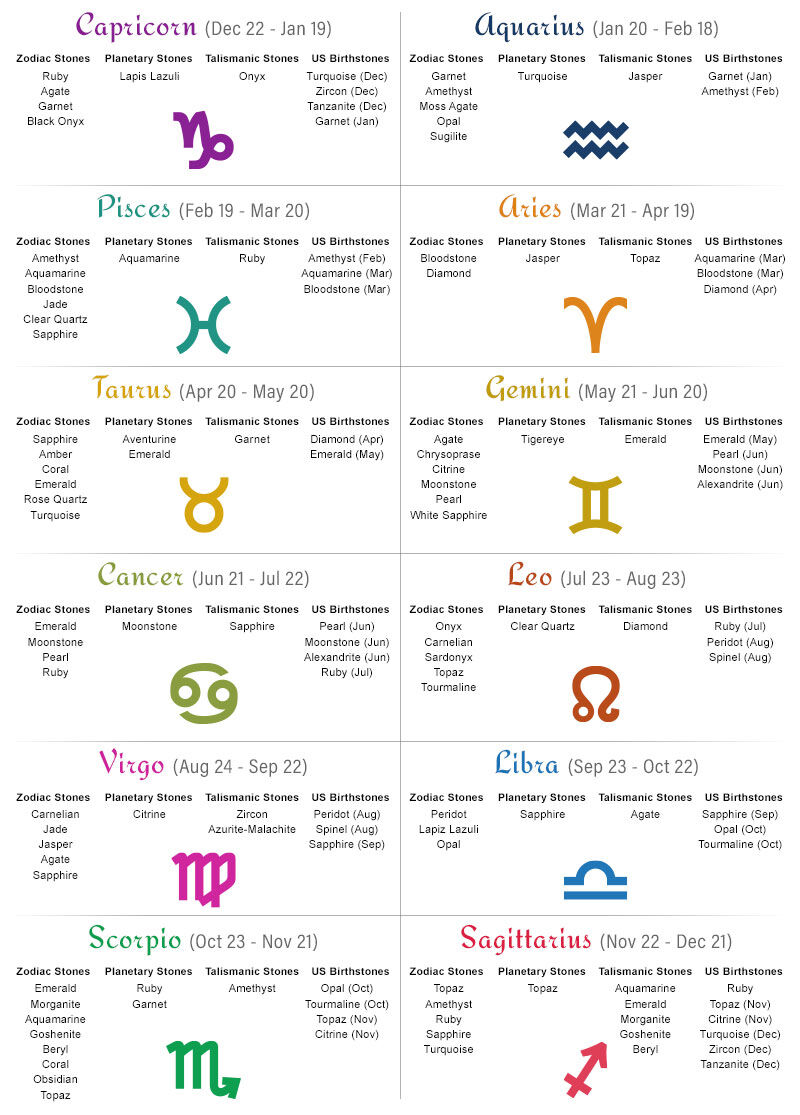
Read ''Birthstone Jewelry'' for more details information on birthstones specifically, ''12 and 12 More: Alternate Choices for Birthstones'' to explore other birthstone options and ''Astrological and Zodiac Jewelry'' for more about designing with your zodiac in mind.
4. Color Mala
Color alone can be enough of a reason to select a gemstone for use in malas. According to color psychology, humans have subconscious reactions to color. Of course, if a color is your favorite, you may be affected slightly differently than someone else, but there are some general associations with color. Choose your favorite color or choose gemstones based on qualities you'd like to encourage and amplify.
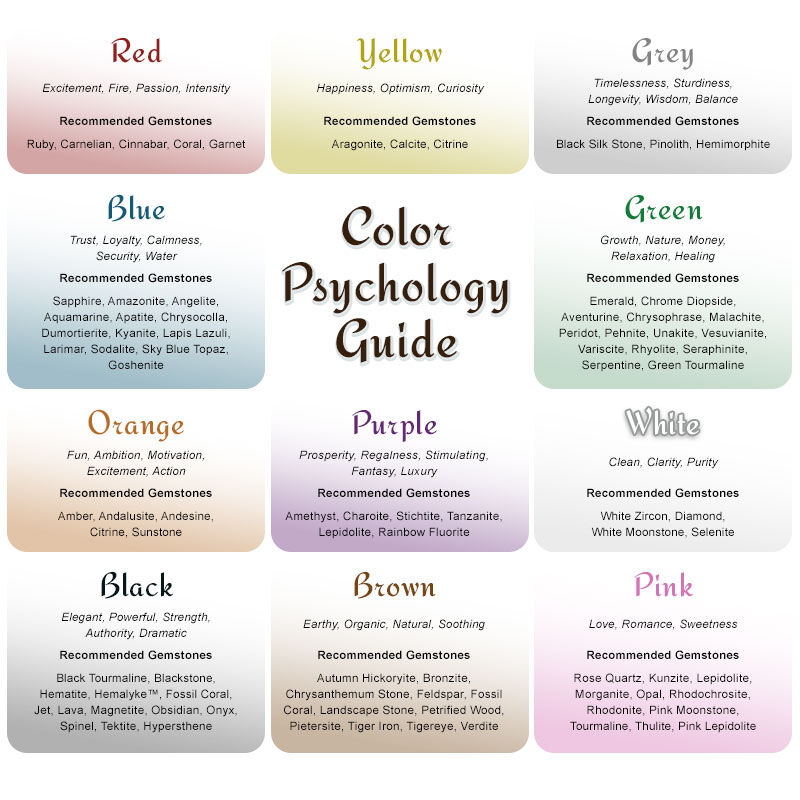
How to Design a Mala
Now it's time to plan the rest of the mala design. As mentioned previously, tassels are common, but not required. Or you can attach focal components with symbolism to the tassel or add a large gemstone before the tassel. You can even replace the tassel with a large focal, bead, etc. Popular components included with malas are the Hamsa Hand, lotus flower and Om symbol. All three of these have strong symbolic ties to Buddhism or Hinduism, which makes them especially complementary for use in malas. You can learn more about these and more iconography in the ''Cultural Symbols in Jewelry'' chart.

Additional suggestions of symbols to consider using include:
- Angel Wings - Angels are representative of love, support, protection, healing and guidance. This creates a nice bridge with the fact that prayer beads are related to malas.
- Buddha - The "awakened one" or "enlightened one" who was said to have discovered Dharma. There are two visual representations of Buddha.
- Butterflies – The butterfly's connotations of transformation, rebirth, the soul, freedom, inspiration and openness fit well with many mantras.
- Dragonflies - These insects typically represent wisdom of change, adaptability, self-realization and emotional maturity.
- Elephant - These noble creatures are revered in many cultures while representing pure beauty, strength and wisdom in Buddhism.
- Feather - Connotations of spiritual evolution and transcendence. Particularly revered by Native Americans as a symbol of honor and connection to the Creator, trust, strength and freedom.
- Goddess - A beautiful symbol that is especially empowering for women. The ancient goddess symbol represents love and fertility. Consider metaphysical properties of goddess gemstone focals to give your mala even more direct focus here.
- Tree of Life - A symbol found in cultures all over the globe, representing growth and many types of connections such as spirituality and family. A symbol sometimes seen used with Hamsa Hands and depictions of Buddha, too.
- Triskele - Represents the concept of progression, action and connection. This and other Celtic symbols would also be an interesting merging of cultures, since the first rosary did come from Ireland.
Find what speaks to you!

How to Make a Mala
Gather your materials: cord or stringing material of choice, beads, guru bead, scissors, tassel and any extra charms, pendants or embellishments you want to include.
Cut a 5-foot length of cord for a traditional 108 bead mala using 6mm or 8mm size beads. If using larger beads or incorporating spacer beads between the mala beads, give yourself more cord to work with.
Tie off one end of the cord, leaving a 5- to 8-inch tail that will later be used as the tassel or a connection point for your other adornments.
String your beads in the order you desire, knotting between each or adding your spacer beads. A knotting tool such as The Bead Knotter™ would help make quick work of knots. View the ''Secrets to Using a Bead Knotting Tool'' how-to video for tips and tricks.
Add your guru bead. If using a T-drilled bead, this can be tricky. Reference the ''Fire Mountain Fix: T-Drilled Beads'' how-to video for a tip on getting this crucial mala component strung.
Using the two ends of your cord, tie a simple knot to complete the circle. It's recommended to use a dab of G-S Hypo Cement® to ensure the knot is secure.
Attach your tassel or additional embellishments by threading both cord ends through the loops or stringing holes. You can use existing tassels or make your own with the Beadalon® tassel maker. This how-to video ''How to Create Tassels Using the Beadalon® Tassel Maker'' shows the steps.
Snip off any extraneous cording.
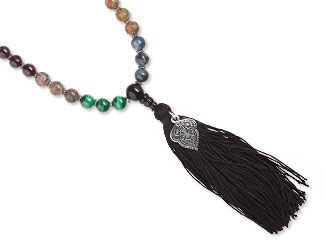
Start meditating!
Remember Your Mantra
If you're designing a mala for yourself, it's helpful to think of your mantra while in the designing process. Start saying your mantra as you create the mala, infusing the beads with your intent early on. If making malas for other people, you're welcome to have mantras in mind. Display the mala with the mantra or intention of the particular mala you created to let customers know what the focus of the mala design is. If you chose specific beads and materials for a reason, attach a little tag explaining the significance. Customers will love looking through the malas to find the right one that speaks to them.
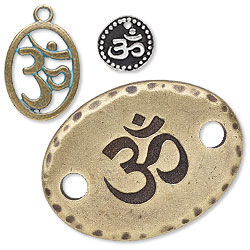
What is a Mantra Anyway?
Mantras are prayers, phrases, words or even sounds. As stated earlier, these can be said aloud or mentally as you focus on achieving deeper states of consciousness during meditation and yoga. The Om symbol, also Aum, is a perfect example of a mantra many people are familiar with. Om is a primordial sound of the universe that represents the cosmic beginning of creation in Hinduism.
What Are Common Mantras?
Anything can be a mantra! Find what speaks to YOU. Try positive affirmations and statements of worth. Some chakras may respond particularly well to certain mantras such as (but not limited to) the seven "bija mantras." Bija means "seed," and these single-syllable sounds are believed to activate specific chakra energy:
- Crown chakra: Om
- Third Eye chakra: Om
- Throat chakra: Ham
- Heart chakra: Yam
- Solar Plexus chakra: Ram
- Sacral chakra: Vam
- Root chakra: Lam
Some popular mantras* are:

*If spelling, pronunciation or meanings are not perfectly accurate, please allow for some errors in translation.
What if My Mala Breaks?
If your mala breaks, it's not actually a bad thing. There's no ill omen or negative energy that results from a broken mala. In fact, this is often viewed positively, since it means you've been regularly using your mala with purpose and intent. The breaking of the mala can be viewed as a physical representation of breakthroughs and a sign of progress. You can always string the mala again and continue as before or change the beads in your mala to adjust for a new or modified meditation.
**Please note that all metaphysical or healing properties listed are collected from various sources. This information is offered as a service and not meant to treat medical conditions. Fire Mountain Gems and Beads® does not guarantee the validity of any of these statements.
Shop for Your Materials Here:
Have a question regarding this project? Email Customer Service.
Copyright Permissions
All works of authorship (articles, videos, tutorials and other creative works) are from the Fire Mountain Gems and Beads® Collection, and permission to copy is granted for non-commercial educational purposes only. All other reproduction requires written permission. For more information, please email copyrightpermission@firemtn.com.
